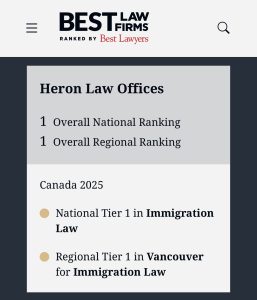Canadian Immigration Lawyer Katie Lay provides an overview of pathways for migrant workers who are experiencing abuse and discusses important case law advocates and workers should know about

Hello Heron Law Blog Readers! Today I want to talk to you all about something that’s very close to my heart – migrant worker rights. Specifically, I want to talk to you about what migrant workers who are at risk of abuse or who have experienced abuse in the workplace can do to protect themselves and their status in Canada. Although there are a number of programs through which foreign workers can come to and work in Canada, in this post, I will be referring specifically to the Temporary Foreign Worker Program and workers who are employed in Canada under the program. As a disclaimer, everything included in this post is legal information, not legal advice, and if you are interested in pursuing any of the processes outlined in this post you should seek legal counsel to advise you based on your specific circumstances.
Background – What is an Employer-Specific Work Permit?
Under the Temporary Foreign Worker program, all work permits are employer-specific. As the name suggests, employer-specific work permits tie a worker to a particular employer and a particular position with that employer, as opposed to open work permits, which allow workers to work for any employer. If the worker changes positions within the company, or wants to change employers, they are required to obtain a new work permit that authorizes them to work under those circumstances. As part of the work permit application process, employers hiring under the Temporary Foreign Worker Program are required to obtain a Labour Market Impact Assessment (LMIA) that indicates that there are no available candidates for the position in Canada, and that a foreign worker is required to fill the position.
The employer-specific work permit system provides employers with a significant amount of power over temporary foreign workers, even more power than is usually found in a typical employee-employer relationship. Workers on employer-specific work permits are a particularly vulnerable group, as their status in Canada is inextricably linked to their employment. Workers under the Temporary Foreign Worker Program are not able to leave their jobs without losing the ability to work and putting their status at risk, which means they may end up in dangerous and abusive situations that they are not able to flee. It is common for workers to face financial abuse, such as wage non-payment; emotional abuse, including threats of termination and deportation; physical abuse, which may include forcing a worker to work in unsafe conditions; and sexual abuse. For more information on workplace abuse, including examples and information on applying for a VWOWP, visit the IRCC Operation Instructions and Guidelines on VWOWPs.
Vulnerable Worker Open Work Permits
In June 2019, IRCC established a new type of open work permit to allow vulnerable migrant workers to leave abusive employment situations without fear of losing their status in Canada or ability to work to support themselves. The Vulnerable Worker Open Work Permit (VWOWP) does not have an application fee, and requires a worker to provide evidence of abuse or risk of abuse in the workplace. It is established under R207.1 of the Immigration and Refugee Protection Regulations (“IRPR”). The VWOWP is an expedited process, and officers are required to respond to applicants within 5 business days of the submission of their application. If the assessing officer determines that the applicant is experiencing or at risk of experiencing abuse such that it is unsafe for them to remain in their current employment situation, they may be issued an open work permit valid for up to 12 months. The open work permit will allow them to work for any employer, and the goal is to allow workers to find a new employer who can provide them with an LMIA so they can apply for a new employer-specific work permit. Family members of individuals who are issued a VWOWP may also be eligible for a work permit. The VWOWP is not extendable except for in very specific circumstances where the worker’s original work permit is longer than the issued VWOWP.
In order to be eligible for a VWOWP, the worker must meet the following criteria:
- Foreign worker must be in Canada – you cannot apply for a VWOWP if you have left Canada.
- Must have a valid work permit – if your work permit has expired, you are not eligible to apply for a VWOWP.
- Must be at risk of abuse – you must provide evidence that you are at risk of abuse in the course of your employment, or evidence of the abuse you have experienced. For example, copies of emails, text messages, videos, photos, sworn statements, copies of pay stubs indicating wage non-payment or excessive work hours, really anything you have available to you. Affidavits, or sworn statements of fact, are also often used to show risk of abuse or evidence of abuse that applicants may not have other documentary evidence of.
Other Options – Humanitarian and Compassionate Applications
If you do not meet the criteria for a VWOWP, there are two other options you may have available to you. First is applying for a Temporary Resident Permit and an accompanying Open Work Permit, which will be an explanation for another day. Instead, I’m going to focus on the second option, which is making an application for permanent residency with humanitarian and compassionate considerations (H&C).
When you make an H&C application pursuant to s. 25(1) of the Immigration and Refugee Protection Act (“IRPA”), the applicant is effectively asking the government to make an exemption for a particular requirement so they can be eligible for permanent residency when they would not otherwise be. In some cases, applicants may be able to request expedited first stage approval due to the abuse they have experienced and their need to secure their status given the dangerous circumstances they are facing.There are restrictions on who is eligible to apply for an H&C, so be sure to consult legal counsel before beginning the process. H&Cs are discretionary, and it is up to the decision-maker to determine if an applicant’s circumstances warrant an H&C exemption. However, there are still some requirements that decision-makers must follow.
The Supreme Court in Kanthasamy v Canada (Citizenship and Immigration), 2015 SCC 61 [Kanthasamy] outlines the mandated approach to H&Cs. In Kanthasamy, the Court held that “officers making humanitarian and compassionatedeterminations must substantively consider and weigh all the relevant facts and factors before them” [25]. In the case of workers who are experiencing or have experienced workplace abuse and are not eligible for a VWOWP, evidence of said abuse must be assessed by IRCC officers if provided as part of an H&C.
Case Law on H&Cs for Migrant Workers Facing Abuse
How does the requirement that officers consider and weigh all the relevant facts and factors before them when making a decision regarding an application impact foreign workers who experienced abuse? I will highlight a couple cases below that demonstrate how migrant workers who have faced abuse in the workplace have had their H&C applications assessed at the Federal Court level.
In Kaur v. Canada (Citizenship and Immigration), 2018 FC 777, the court determined that the officer’s decision “to ascribe only little weight to the circumstances surrounding the loss of Ms. Kaur’s employment in Canada was not consistent with the approach mandated by the Supreme Court in Kanthasamy,” and was therefore unreasonable [2]. Ms. Kaur was subject to financial and emotional abuse by her employer, who threatened to terminate and deport Ms. Kaur if she complained about the abuse she experienced [4]. The employer eventually did follow through on his threat, and terminated Ms. Kaur, who was unable to find a new job that could provide her with an LMIA, giving her no choice but to leave Canada [5]. The officer gave minimal weight to the treatment Ms. Kaur faced during the course of her employment, and determined that Ms. Kaur’s work permit application “was ultimately refused due to her inability to obtain a new LMIA” [9]. The Honourable Mr. Justice Fothergill held that the officer’s decision was unreasonable, and inconsistent with the approach mandated by the Supreme Court in Kanthasamy. Justice Fothergill summarizes his concerns regarding the treatment of migrant workers who have experiences abuse as follows:
“A troubling implication of the officer’s decision is that foreign workers who endure fraud or abuse in the course of their employment, and who are threatened with termination and deportation, can expect little sympathy from those who administer Canada’s immigration laws” [18].
The Court in Bobadilla v. Canada (Citizenship and Immigration), 2022 FC 161 used a similar approach to assess Ms. Bobadilla’s H&C application. Ms. Bobadilla sought assistance from an employment agency to change employers while she was in Canada, and had her application denied due to delays in obtaining a new LMIA [5]. From the time her application was refused to the hearing of this matter, Ms. Bobadilla was without status in Canada. She applied for an H&C, which was refused in 2019, and sought to sue the employment agency, which had allegedly charged her illegal recruitment fees and deducted wages unlawfully [6]. The applicant filed an H&C as a way to overcome her inadmissibility due to lack of immigration status [18]. The Court held that “the Officer here did not consider the adverse effects of the employment agency’s involvement in the steps taken to obtain status and showed no compassion for the Applicant’s circumstances. This is contrary to the approach called for by the Supreme Court in Kanthasamy” [21]. Justice Mosley highlights the importance of the Kanthasamy analysis process, and states that the “decision does not represent a reasonable outcome based on the law and the evidence” [24].
It is evident that IRCC Officers do have an obligation to consider the totality of the evidence and circumstances that have led to the need for an application on humanitarian and compassionate grounds. In the case of Ms. Kaur, the abuse she experienced during the course of her employment was at the heart of her need for a humanitarian and compassionate application, as the mistreatment and subsequent termination of employment are what put her in the position of needing a new employment and a new work permit [17]. In Ms. Bobadilla’s case, the officer did not consider the adverse impact that the employment agency had on the applicant or her attempts to regain status, and had no compassion for Ms. Bobadilla’s circumstances. These are important facts and factors that must be considered and weighed by an assessing officer.
H&Cs are difficult, time consuming, and a difficult but sometimes necessary path for otherwise inadmissible migrant workers. This blog post has covered only a very specific aspect of H&Cs, which are complex, multifaceted applications that people write entire books about. I hope this very general overview has provided you with some new useful information, and perhaps taught you a bit about how exploitative the Temporary Foreign Worker Program can be. If you are a temporary foreign worker who needs assistance, reach out to me at Heron Law Offices, or get in touch with the wonderful people at the Migrant Workers Centre, which provides legal services to low-income migrant workers in British Columbia.




